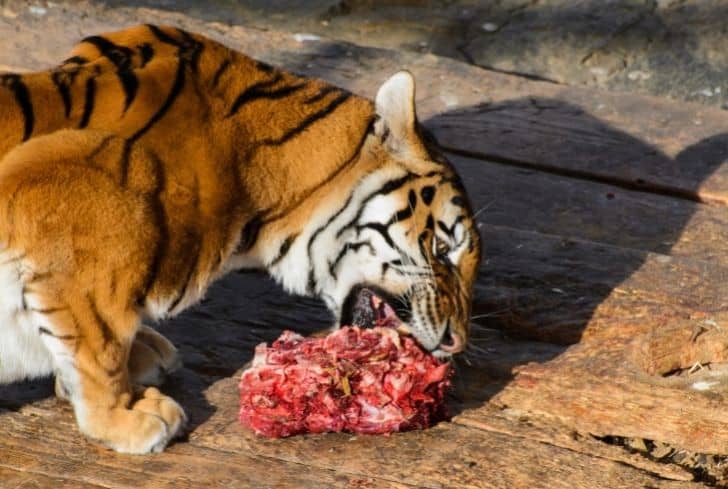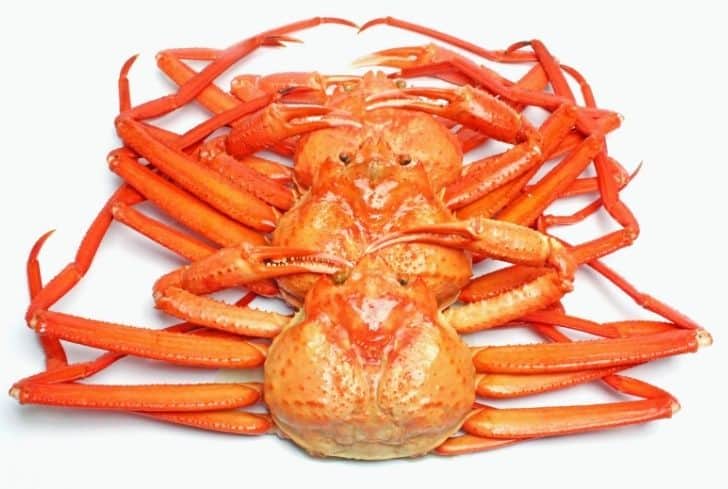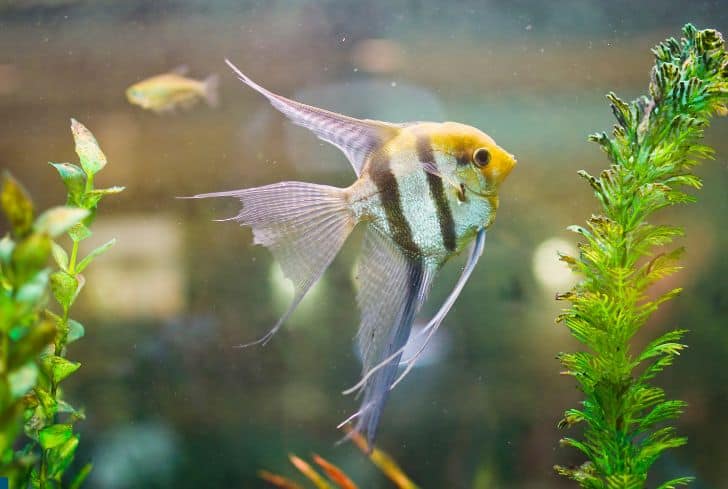5+ Reasons Why Can Animals Eat Raw Meat

Animals come in different shapes, sizes as well as species. They have varying feeding habits, which may be carnivorous, herbivorous, or omnivorous. Some animals can feed on plants and meat, while others can only eat either of the two.
Why can animals eat raw meat? This is a frequently asked question. However, we must first address the underlying assumptions to answer them effectively. The belief that animals can eat raw meat without having problems is false.
In the wild, carnivores hunt and kill prey to survive. From eating the flesh of other animals, these carnivores might develop some diseases. Even more commonly, they contract parasites. Nonetheless, they eat their meat raw because they quite obviously can’t cook it.
Saying that animals can eat raw meat doesn’t necessarily mean that it has to be fresh. However, fresh meat is easier than rotten or decaying meat on the digestive tract.
Not all animals can eat decaying animal protein because their digestive systems aren’t modified for that kind of feeding. Science plays a significant role in helping us understand why animals can eat raw meat.
5+ Reasons Why Animals Can Eat Raw Meat
We’ve established that animals can eat raw meat. Now, let’s look more closely at the reasons for this. Animals can eat raw meat due to various factors, which are not as straightforward as you might assume.
1. It is eaten while fresh
One critical reason animals can eat raw meat is that they eat the meat while it is fresh. Of course, there are exceptions to this rule, as seen with the vultures. Unlike humans, wild animals eat their prey right after they kill it. They don’t process or store the meat for later consumption.
Eating the prey immediately after the kill ensures that the meat is still fresh and hasn’t begun to decay. In other words, bacteria haven’t had time to grow on the flesh.
2. Well-adapted digestive systems
Animals can also eat raw meat is that they have well-adapted digestive systems. Wild animals have more concentrated acids in their stomach. Their stomachs have evolved, making them much more different from ours. The digestive system of some animals has even evolved to the extent that they have a built-in mechanism to flush toxic meat from their system.
The vital acids in their digestive system would kill more bacteria than the human stomach would.
3. Varying digestive systems
Scientists have also discovered that some animals are resistant to bacteria, while others who consume the same diet could become infected and sick. As a result, it varies by species, and not all animals can get away with consuming raw meat. Many animals don’t live till maturity due to parasites or bacterial infections caused by their diets.
4. A robust immune system
Animals in the wild can eat raw meat because of their robust immune system. The immune system of wild animals has evolved. This gives them the ability to resist the various infections they could contract from the bacteria they’re continuously exposed to through their diet.
5. Heightened senses
Another reason animals can eat raw meat is that they have a better sense of smell. You might ask, how does their sense of smell relate to them being able to eat raw meat? Their improved sense of smell helps them determine what type of meat is good or bad. It allows them to judge what type of meat they should or shouldn’t eat.
6. Necessity
Animals, especially wild ones, don’t choose to eat raw meat; they consume it because that’s what’s available. Animals in the wild can’t choose to have their meat prepared for them, and most of them will die without ever tasting cooked protein. The same can’t be said for domesticated animals or pets under our care.
Can Animals Eat Rotten Meat?
In most ecosystems, rotten meat, also known as carrion, is essential for large carnivores and omnivores.
Aside from the fact that rotten meat isn’t good for human health, it generally doesn’t taste good. For us humans, it is better to eat fresh to avoid stomach complications. On the other hand, some animals are well adapted to eating rotten meat.
It’s important to stress that not all animals can eat rotten meat. Animals that eat it are known as scavengers. Examples of such animals are vultures, bears, and snapping turtles. They can eat meat at various stages of decay.
Scavengers don’t kill their mark. Instead, they wait for other animals to kill prey and eat the leftovers. Vultures, for example, can eat decaying meat because their digestive system contains a unique set of acids and enzymes. In some cases, vultures eat other dead vultures if they get hungry and don’t find other desirable food.
Most animals would be poisoned by eating rotten meat regularly. On the other hand, Vultures appear to have evolved by creating extremely damaging stomach acids. They also have gut flora that allows them to thrive on carrion diets.
Before thinking about the larger animals like vultures and bears, we should think about the smaller animals, like insects. These scavengers have digestive systems designed to process high bacteria loads without causing them harm.
Why Don’t Animals Get Sick After Eating Raw Meat?
The assumption that animals don’t get sick after eating raw meat is incorrect. Animals sometimes get ill from eating raw meat. As a result, most of these flesh-eating animals die off very young. It’s more acceptable to say that some animals are more adapted to eating raw meat than others.
Pure carnivores have digestive systems that are very different from other animals. Their digestive tracts are very simple and short, unlike in herbivores and carnivores. They can digest pathogenic bacteria – these are disease-causing bacteria.
Their simple and short gut implies that the food spends relatively little time there, passing through it faster. Also, as previously mentioned, their stomachs contain a potent acid.
Suppose we compare bacterial cultures taken from store-bought vegetables with bacterial cultures taken from freshly killed gazelle meat. In that case, we’ll find that the gazelle meat is least likely to be contaminated. This is because the gazelle meat hasn’t been exposed for long, and the chance for pathogenic bacteria to have grown on it is very little.
Can Humans Eat Raw Meat?
To answer this question, yes, humans can eat raw meat. Although, eating raw meat isn’t as simple and without complications as just saying it. Eating raw meat has been a common practice in many cultures worldwide for a very long time. While this is a widespread practice, various things need to be considered.
Carnivorous animals like wolves and lions have teeth that are built to slice through elastic animal muscle like a pair of scissors. This makes them effective raw meat-eaters. On the other hand, human teeth function as a mortar and pestle. They are made for crushing rather than slicing.
According to research, human teeth cannot adequately break down raw meat due to their flat surface. Researchers also noted that early humans most likely chopped theirs up with stone tools to make it edible.
When we chew raw meat, it doesn’t split apart easily. Hence, a few things have to be done before it can be eaten raw. Cooking facilitates the chewing and digestion of food, helping the body absorb more of the available nutrients.
Research done by scientists indicates that a raw meat diet is very feasible. High-end restaurants include raw meat dishes on their menu. These dishes include; sushi, steak tartare, ground beef ceviche, also called Carne apache, beef carpaccio, and Mett. However, while these are all edible dishes, they aren’t always safe to eat.
As a result, these high-end restaurants have to adhere to the highest safety standards. Despite this, there’s still a chance of contracting bacterial infections from consuming any of these dishes.
According to the U.S. Department of Health and Human Services, raw meat may also contain Salmonella, E. coli and other parasites. The only way to destroy these microorganisms is to cook the meat thoroughly.
Bacteria live and proliferate at temperatures ranging from 4 to 60 degrees Celsius. As a result, it’s safer to cook meat until its interior temperature has reached at least 65 degrees Celsius. This helps to break down bacterial cells and prevent them from replicating successfully.
You’re probably wondering if this is true; how then have humans survived on raw fish meat over the years? Also, what about raw fish in dishes like sushi? The saltwater and the temperature of the water the fish are gotten from making a huge difference. Raw saltwater fish is safer to consume than freshwater fish because the water’s salt helps remove bacteria and parasites.
Another thing is that most bacteria can’t thrive at temperatures below 4 degrees Celsius. Sushi-grade fish, also known as sashimi, is typically eaten uncooked and is usually frozen to help kill any bacteria that may linger.
Conclusion
Raw meat consumption is usually more common in animal diets, as they’re well adapted to this kind of feeding. That isn’t to say that humans don’t also consume raw meat. Raw meat is considered a fine cuisine in several places. People eat meat at different stages of rawness.
Meat from fish is eaten raw as sushi, and beef is eaten as a steak. Although several countries, such as Japan, incorporate raw meats into their diets, no civilization has been discovered that has solely relied on raw meat for food. While these dishes are popular in high-end restaurants, we shouldn’t make eating raw meat a regular habit to avoid complications.





